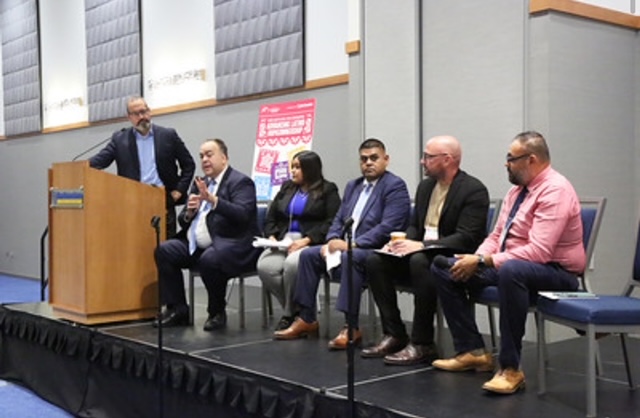In 2023, there were more than 9.5 million Latino homeowners in the United States, according to a report by the National Association of Hispanic Real Estate Professionals®. In Chicago, the nonprofit Prosperity Now reported that the figure stood at around 43% in 2017.
While the national rate of Latino homeownership is trending upward, barriers remain. According to NAHREP, high interest rates, a lack of conventional financing options for people without Social Security numbers, and high rates of mortgage denials all make it harder for Latinos to achieve homeownership.

For the latest installment in its ongoing Racial Equity and Real Estate series, the Cook County Assessor’s Office hosted “Advancing Latino Homeownership” on September 25 at Northeastern Illinois University. Dr. Katrina E. Bell-Jordan, President of NEIU, introduced the event, and Alderperson Jessie Fuentes (26th Ward) delivered the keynote address. “These conversations are necessary to enact change and reform policy,” said Cook County Assessor Fritz Kaegi.

Kaegi explained how, in the past, assessors tended to over-assess homes “at the bottom end of the price spectrum.” “This is a big problem,” he said. “Basically, people would take a look at neighborhoods like on the Southwest Side. You might have a Latino neighborhood right next to a wealthy neighborhood like Beverly. And if you average the sales prices between those two, guess what’s going to happen? You’re going to have undervaluation of the rich white neighborhood and overvaluation of the Latino neighborhood.”
The event featured two panels. The first was “Advancing Latino Homeownership: assessments, policy, gentrification, real estate,” moderated by Hugo Balta, Publisher of Illinois Latino News. Participants included Assessor Kaegi; Norma Hernandez, Illinois State Representative (77th District); John Schlichtman, DePaul University Professor and author of Gentrifier; David Dominguez, CEO of Chicago Realty; and Gerardo Ravelo, Home Purchase and Financial Empowerment Program Manager, The Resurrection Project.

“The challenges are there still. Communities still face barriers when it comes to language, the process – there’s a culture where our community doesn’t trust the banks,” said Ravelo. “What I’m seeing are multiple generations, multiple families, coming together to pitch in so they can purchase that dream home.”

Balta argued language should no longer be a barrier. “The second most popular language spoken in this country es el español. Si hay una persona aquí que no entiende lo que estoy diciendo, usted es una minoría,” Balta said. “Speaking Spanish is essential to conduct business in the U.S.”

“Our people are buying homes. For the age group of 18 to 24 in the western suburbs, 20.8% of Latinos own homes compared to our white counterparts at 11.8%. So our younger population has a higher rate of being homeowners than any other ethnic demographic,” said Rep. Hernandez. “The farther out of the Chicago region that Latinos are moving to, the more likely they are to be homeowners.”
Some 1.2 million Latinos, or more than 50% of Latinos living in Illinois, live in the suburbs of the seven counties in the Chicago metro region, according to Latinos in the Suburbs: Challenges & Opportunities, a report by the Latino Policy Forum, in partnership with The Metropolitan Planning Council and UIC’s Great Cities Institute. Between 1990 and 2000, the Chicago metro region’s Latino population grew by approximately 570,000, with the suburbs experiencing a growth of more than 360,000 in Latino population, while Chicago’s Latino population grew by just over 200,000. That diverging population trend continues today. For example, between 2010 and 2020, about 84% of the Latino population growth in the Chicago metro region happened in the suburbs, and only about 16% occurred within the city of Chicago.

“Before our Hispanic community were renters, now we are landlords. And not just one building, we are buying multiple buildings, and that’s something we pride ourselves so much,” said Dominguez. 16.3% of landlords in the United States are Latino, while 67% are white. The number of Latino landlords has been increasing, from 13% in 2010 to 16% in 2019.

Schlichtman offered a definition of gentrification, “Gentrification is global. And what’s happening all over the world is that properties that were devalued are being rapidly revalued.” There isn’t much information about the exact number of Latinos displaced by gentrification in Illinois, but experts estimate that between 2000 and 2017, the Latino population decreased by about 22,000, while the white population increased by over 12,000. Between 2000 and 2013, the neighborhood experienced gentrification as coffee shops, artisan bakeries, and upscale restaurants opened up. The Hispanic population decreased from 89% in 2000 to 81.6% in 2013.
Schlichtman explained how gentrification causes cultural and economic displacement, but at the root of it is the loss of home space. “I think that’s where our politics need to go, to this idea of home,” he said. “Move slowly and inclusively using community wisdom. If you don’t do that, the changes are not sustainable.”
Information about past Racial Equity and Real Estate Conversation events can be found at https://www.cookcountyassessor.com/racial-equity-and-real-estate-conversations.
